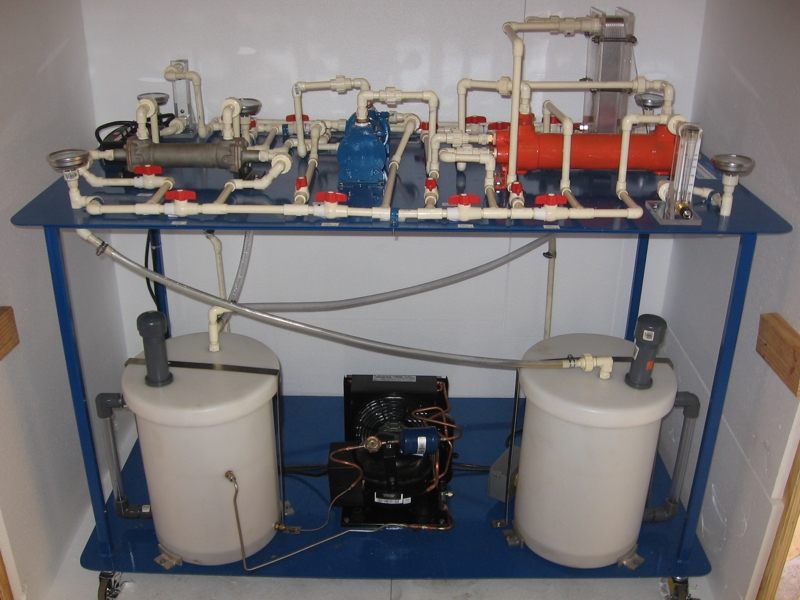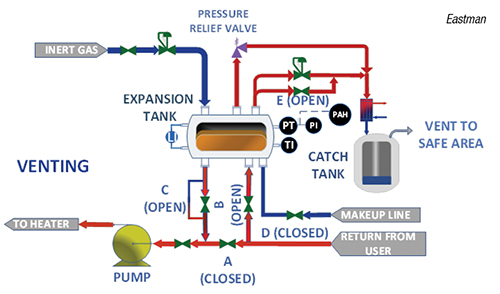Advancements in Heat Transfer Solutions: What You Required to Know for Optimum Performance
Developments in Heat transfer systems are transforming efficiency across numerous markets. Advanced products like graphene and nanofluids assure considerable renovations in thermal conductivity. The integration of IoT and machine understanding supplies opportunities for real-time monitoring and improved energy performance. The landscape of thermal administration is quickly progressing. Understanding these growths is essential for achieving optimal system efficiency and sustainability in the future. What certain advancements are forming this transformation?
Arising Products for Improved Heat Transfer

Advanced Heat Exchanger Layouts
While typical Heat exchangers have offered their objective in numerous applications, progressed designs are now emerging to meet the increasing demands for effectiveness and performance. These cutting-edge styles, such as plate, shell-and-tube, and finned-tube Heat exchangers, integrate boosted surface areas and improved circulation patterns to enhance thermal transfer prices. On top of that, portable layouts permit decreased room requirements without endangering effectiveness. Advanced products, such as composites and corrosion-resistant alloys, additionally improve longevity and efficiency under extreme problems. Simulation modern technologies and computational fluid characteristics are significantly used to fine-tune these layouts, making certain peak Heat transfer features. As sectors look for to reduce energy intake and take full advantage of result, the fostering of innovative Heat exchanger styles is crucial in accomplishing these goals.
The Role of Nanotechnology in Heat Transfer
Nanotechnology plays an important role in boosting thermal conductivity within Heat transfer systems. By adjusting products at the nanoscale, researchers have actually achieved substantial improvements in power efficiency. These innovations not just enhance efficiency however also add to even more sustainable energy services.
Enhanced Thermal Conductivity
Considerable advancements in thermal conductivity have actually emerged with the application of nanotechnology, changing Heat transfer systems across various industries. By including nanoparticles into Heat transfer liquids and materials, scientists have accomplished impressive rises in thermal conductivity. These nanoparticles, such as carbon nanotubes, graphene, and metal oxides, boost the Heat transfer buildings as a result of their high surface location and distinct thermal attributes. The resulting composites exhibit enhanced performance in applications varying from electronics cooling systems to renewable resource modern technologies. The ability to customize the dimension, shape, and structure of nanoparticles permits for maximized thermal management options. As an outcome, nanotechnology remains to play a crucial role in the growth of more effective and effective Heat transfer systems, paving the means for improved industrial applications.
Power Effectiveness Improvements

Combination of IoT in Heat Transfer Equipments
The integration of IoT in Heat transfer systems introduces the implementation of clever sensing units that improve operational effectiveness. These sensing units allow real-time information surveillance, permitting for instant adjustments and optimizations. This technical innovation has the possible to significantly boost efficiency and energy monitoring in Heat transfer applications.
Smart Sensors Application
As Heat transfer systems advance, the assimilation of wise sensing units via the Web of Points (IoT) has official site actually become a transformative method. These sensors make it possible for real-time tracking of circulation, pressure, and temperature rates, enhancing system effectiveness and integrity. By accumulating and transmitting information, they assist in aggressive maintenance, lowering the threat of system failures. Additionally, wise sensing units add to power financial savings by refining operational criteria based upon ecological conditions. Their capability to examine trends and anomalies enables notified decision-making, ensuring peak efficiency of Heat transfer systems. As markets increasingly adopt this technology, the implementation of smart sensing units stands to revolutionize how Heat transfer systems are managed, leading the way for greater sustainability and enhanced efficiency end results.
Real-Time Information Monitoring
How can real-time information checking enhance the effectiveness of Heat transfer systems? By incorporating Web of Things (IoT) innovation, Heat transfer systems can leverage continuous information collection from wise sensors. This real-time surveillance permits for prompt evaluation of pressure, flow, and temperature rates, allowing drivers to determine inefficiencies quickly. Subsequently, modifications can be made to enhance efficiency, minimize energy intake, and expand equipment life-span. Furthermore, predictive maintenance can be applied, minimizing unanticipated downtime and pricey repair services. The capacity to imagine efficiency metrics via control panels enhances decision-making, promoting a positive method to system monitoring. Eventually, real-time data checking not just improves functional performance but also adds to sustainability objectives within commercial procedures.
Energy Performance and Sustainability Trends
Energy performance and sustainability trends are reshaping the landscape of Heat transfer systems, driving innovation and compliance throughout numerous markets. Organizations are significantly prioritizing energy-efficient styles to lower functional costs and lessen ecological impacts. The assimilation of eco-friendly energy sources is coming to be extra prevalent, enabling Heat transfer systems to operate sustainably while meeting regulatory requirements. Additionally, advancements in materials and modern technologies advertise lower power consumption and enhance general efficiency. Lifecycle assessments are likewise getting grip, allowing companies to assess the ecological influence of Heat transfer systems from manufacturing to disposal. This emphasis on sustainability not just supports corporate duty however additionally positions organizations competitively in a market where consumers significantly prefer environment-friendly remedies. Energy efficiency and sustainability stay crucial considerations for future growths in Heat transfer innovation.
Advancements in Thermal Administration Solutions
While the demand for efficient Heat transfer continues to rise, technologies in thermal management options are emerging to address both efficiency and sustainability obstacles. Advanced materials, such as stage adjustment materials and nanofluids, are being created to boost Heat transfer effectiveness - DVS Heat Transfer Systems. These materials boost thermal conductivity and permit much better temperature law in different applications. Furthermore, modern technologies like active thermal control systems are gaining grip, making it possible for real-time modifications to manage Heat flow properly. These systems add to energy savings and lower the environmental impact of thermal procedures. Additionally, the integration of IoT in thermal monitoring facilitates monitoring and anticipating maintenance, ensuring optimized efficiency and durability of Heat transfer systems. Overall, these technologies stand for considerable strides toward even more sustainable thermal management methods
Future Instructions in Heat Transfer Innovation
Arising improvements in thermal management services signal an encouraging future for Heat transfer modern technology. Researchers are progressively concentrating on creating materials with remarkable thermal conductivity and boosted power effectiveness. Developments such as nanofluids, which consist of suspended nanoparticles, offer substantial renovations in Heat transfer efficiency. Additionally, the integration of clever materials that adapt to varying temperature conditions is gaining traction, permitting more responsive and efficient systems. The surge of additive manufacturing strategies is also allowing the design of complicated Heat exchanger geometries that maximize liquid circulation. The application of machine learning formulas is anticipated to reinvent the optimization of Heat transfer systems, promoting anticipating upkeep and efficiency improvement. Collectively, these developments are poised to transform the landscape of Heat transfer innovations in various industries.

Often Asked Inquiries

How Do I Select the Right Heat Transfer System for My Application?
Choosing the best Heat transfer system entails examining application requirements, consisting of temperature varieties, fluid residential properties, and efficiency needs. Examining system kinds, maintenance factors to consider, and cost-effectiveness likewise plays a this website necessary role in making a notified choice.
What Are the Maintenance Needs for Advanced Heat Exchangers?
Maintenance requirements for sophisticated Heat exchangers normally include normal evaluations, checking for leaks, cleaning of surfaces, and home ensuring perfect circulation prices. Sticking to manufacturer standards warranties effective operation and prolongs the equipment's lifespan.
How Do Ecological Aspects Affect Heat Transfer Performance?
Ecological variables significantly affect Heat transfer effectiveness. Variations in temperature, air movement, and humidity impact thermal conductivity and convective Heat transfer, inevitably impacting system efficiency and necessitating factor to consider during the layout and operation of Heat transfer systems.
What Safety And Security Criteria Put On Heat Transfer Systems?
Safety criteria for Heat transfer systems normally consist of standards from organizations such as ASME and ASTM. DVS Heat Transfer Systems. These standards address products, design, and functional practices to guarantee reliability, effectiveness, and protection against dangers in numerous applications
Just How Can I Fix Usual Heat Transfer System Issues?
Troubleshooting common Heat transfer system problems entails looking for leaks, ensuring appropriate fluid flow, checking insulation honesty, and validating temperature differentials. Determining these variables can assist preserve system effectiveness and stop more issues.
Nanotechnology plays an essential role in improving thermal conductivity within Heat transfer systems. Substantial improvements in thermal conductivity have emerged through the application of nanotechnology, changing Heat transfer systems throughout different sectors. Innovations in thermal conductivity through nanotechnology have led the method for impressive enhancements in energy efficiency within Heat transfer systems. Energy performance and sustainability fads are reshaping the landscape of Heat transfer systems, driving technology and conformity across numerous industries. The integration of IoT in thermal management facilitates tracking and anticipating upkeep, making sure maximized performance and long life of Heat transfer systems.